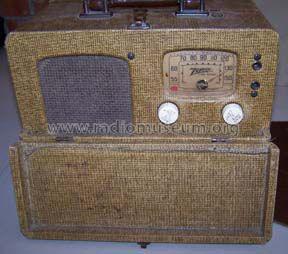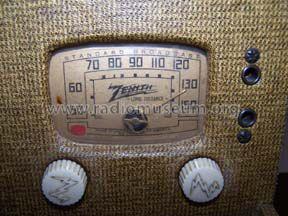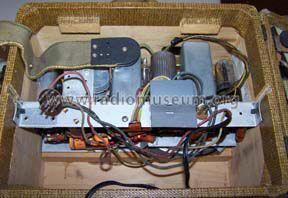5G405 5-G-405 Ch=5537
Zenith Radio Corp.; Chicago, IL
- Land
- USA
- Hersteller / Marke
- Zenith Radio Corp.; Chicago, IL
- Jahr
- 1940
- Kategorie
- Rundfunkempfänger (Radio - oder Tuner nach WW2)
- Radiomuseum.org ID
- 74128
-
- anderer Name: Chicago Radio Lab
Klicken Sie auf den Schaltplanausschnitt, um diesen kostenlos als Dokument anzufordern.
- Anzahl Röhren
- 5
- Hauptprinzip
- Superhet allgemein; ZF/IF 455 kHz
- Wellenbereiche
- Mittelwelle, keine anderen.
- Betriebsart / Volt
- Netz- / Batteriespeisung
- Lautsprecher
- Dynamischer LS, keine Erregerspule (permanentdynamisch) / Ø 5.5 inch = 14 cm
- von Radiomuseum.org
- Modell: 5G405 5-G-405 Ch=5537 - Zenith Radio Corp.; Chicago,
- Form
- Reisegerät > 20 cm (netzunabhängig betreibbar)
- Bemerkung
- listed in Zenith Index 3; produced ?
- Schaltungsnachweis
- Rider's Perpetual, Volume 11 = ca. 1940 and before
- Literaturnachweis
- Zenith Radio The Glory Years 1936-1945 (only the chassis is in Rider´s, not the model)
- Autor
- Modellseite von Konrad Birkner † 12.08.2014 angelegt. Siehe bei "Änderungsvorschlag" für weitere Mitarbeit.
- Weitere Modelle
-
Hier finden Sie 4519 Modelle, davon 4111 mit Bildern und 3656 mit Schaltbildern.
Alle gelisteten Radios usw. von Zenith Radio Corp.; Chicago, IL
Forumsbeiträge zum Modell: Zenith Radio Corp.;: 5G405 5-G-405 Ch=5537
Threads: 1 | Posts: 9
Hi All,
This is my first post here so bare with me!
I have a Zenith 5G405 that I'm nearly done restoring and have started tuning it up. I adjust the trimmer on the tuning capacitor and it only reduces the signal as I turn it in (tighten). There should be a sweet spot where turning one way or the other reduces the signal, correct?
I decided to check the resonat frequency of the RF stage and it is off relative to the local oscillator. For instance, when I tune the radio to 1500 kHz received signal the front end RF tuning resonates at 1200 kHz. Shouldn't the RF stage track the local oscilator?
BTW, the antenna coil and the tuning capacitor forms the front end stage.

Thanks,
John
John Weinrich, 14.Apr.21



